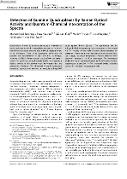Detection of Guanine Quadruplexes by Raman Optical Activity and Quantum-Chemical Interpretation of the Spectra

Autor
Para Kkadan, Mohammed Siddhique
Kapitán, Josef
Kessler, Jiří
Bouř, Petr
Datum vydání
2024Publikováno v
Chemistry - A European JournalRočník / Číslo vydání
30 (70)ISBN / ISSN
ISSN: 0947-6539ISBN / ISSN
eISSN: 1521-3765Metadata
Zobrazit celý záznamKolekce
Tato publikace má vydavatelskou verzi s DOI 10.1002/chem.202403245
Abstrakt
Quadruplexes formed by guanine derivatives or guanine-rich nucleic acids are involved in metabolism and genetic storage of many living organisms, they are used in DNA nanotechnologies or as biosensors. Since many quadruplex geometries are possible the determination of their structures in aqueous solutions is difficult. Raman optical activity (ROA) can make it easier: For guanosine monophosphate (GMP), we observed a distinct change of the spectra upon its condensation and quadruplex formation. The vibrational bands become more numerous, stronger, and narrower. In particular, a huge ROA signal appears below 200 cm(-1). The aggregation can be induced by high concentration, low temperature, or by a metal ion. We focused on well-defined quadruplexes stabilized by potassium, where using molecular dynamics and density functional theory the spectra and particular features related to GMP geometric parameters could be understood. The simulations explain the main experimental trends and confirm that the ROA spectroscopy is sensitive to fine structural details, including guanine base twist in the quadruplex helix.
Klíčová slova
Guanine quadruplexes, Density functional theory, Molecular dynamics, Raman optical activity
Trvalý odkaz
https://hdl.handle.net/20.500.14178/2963Licence
Licence pro užití plného textu výsledku: Creative Commons Uveďte původ 4.0 International







